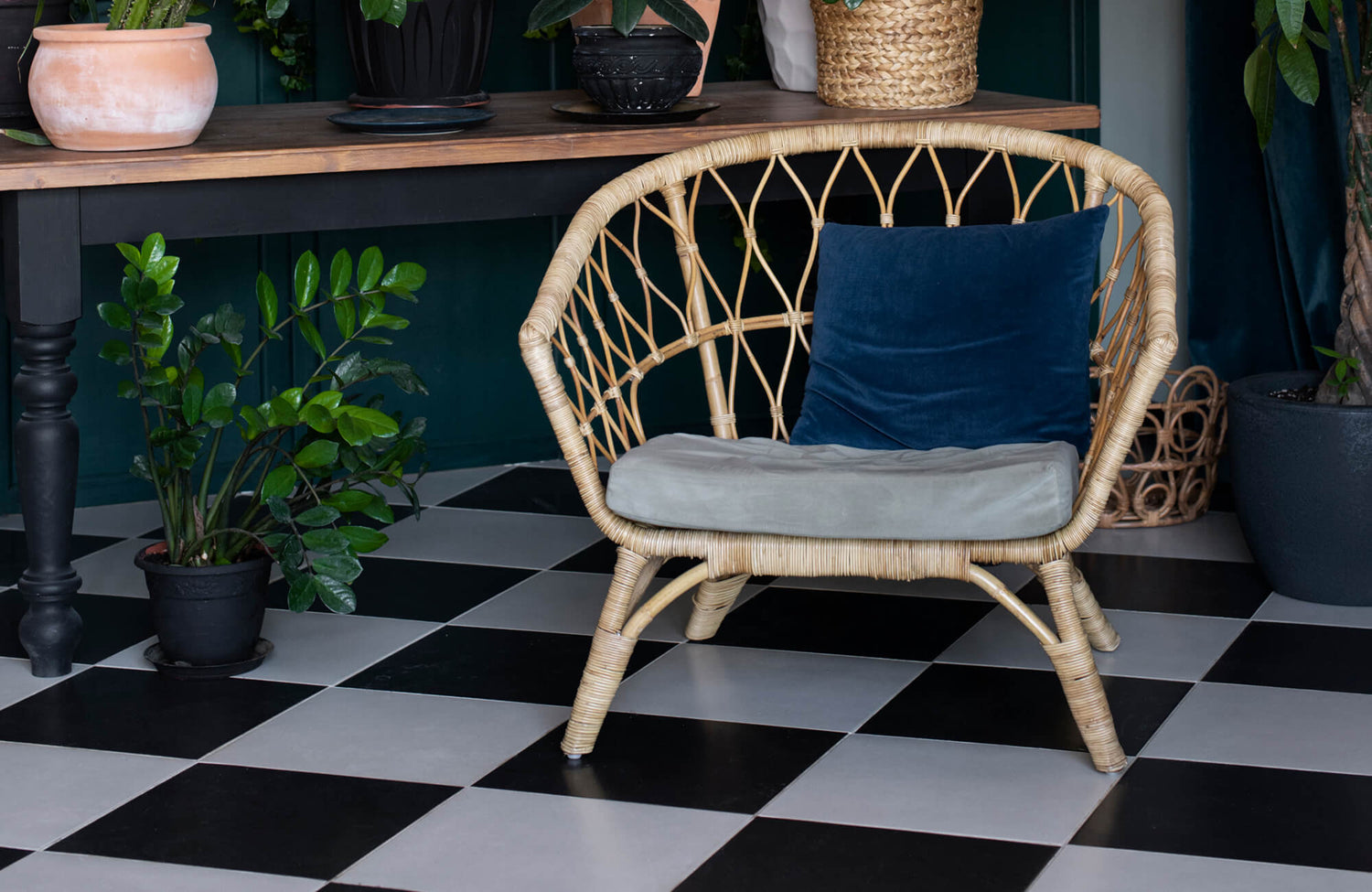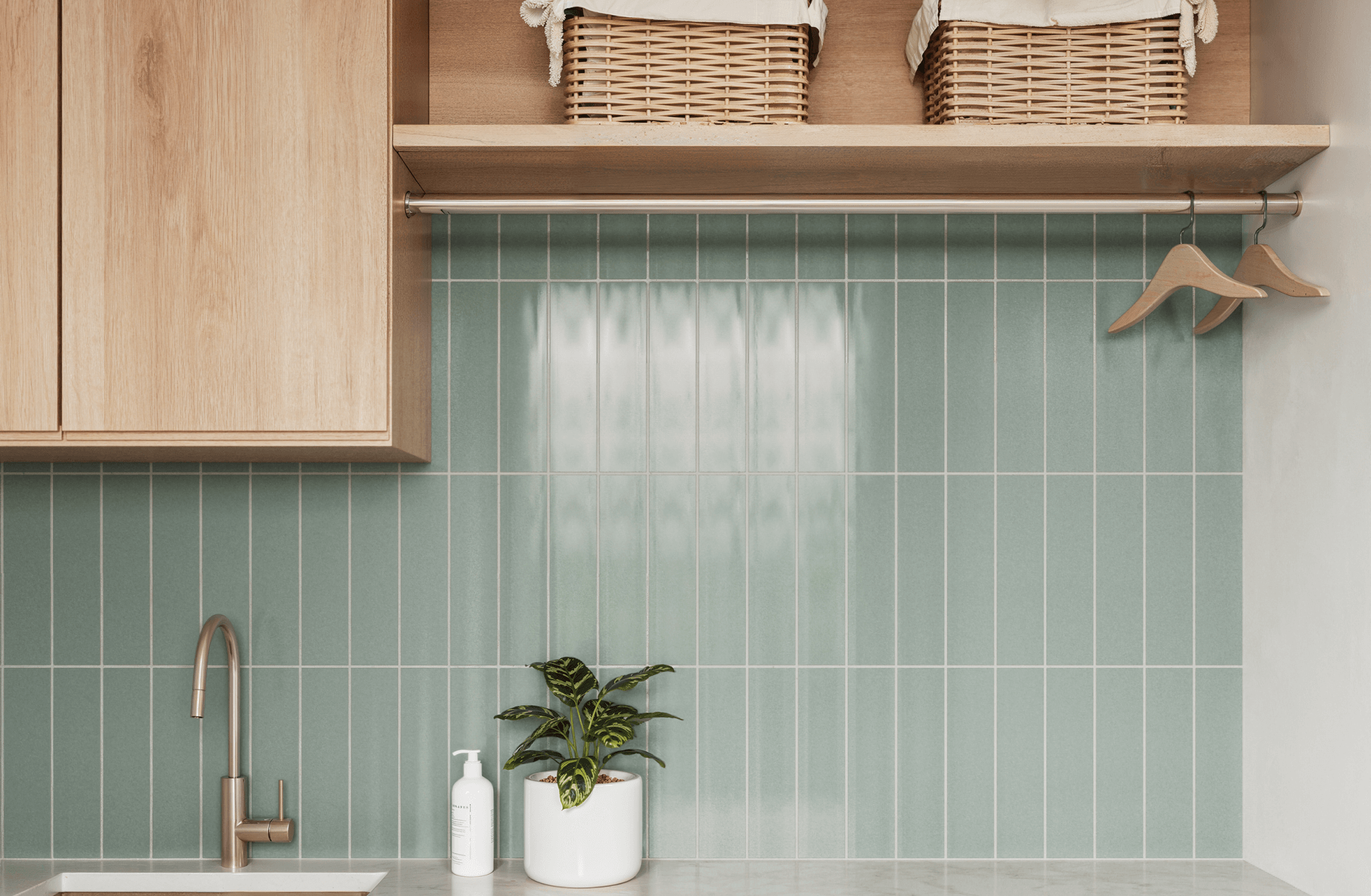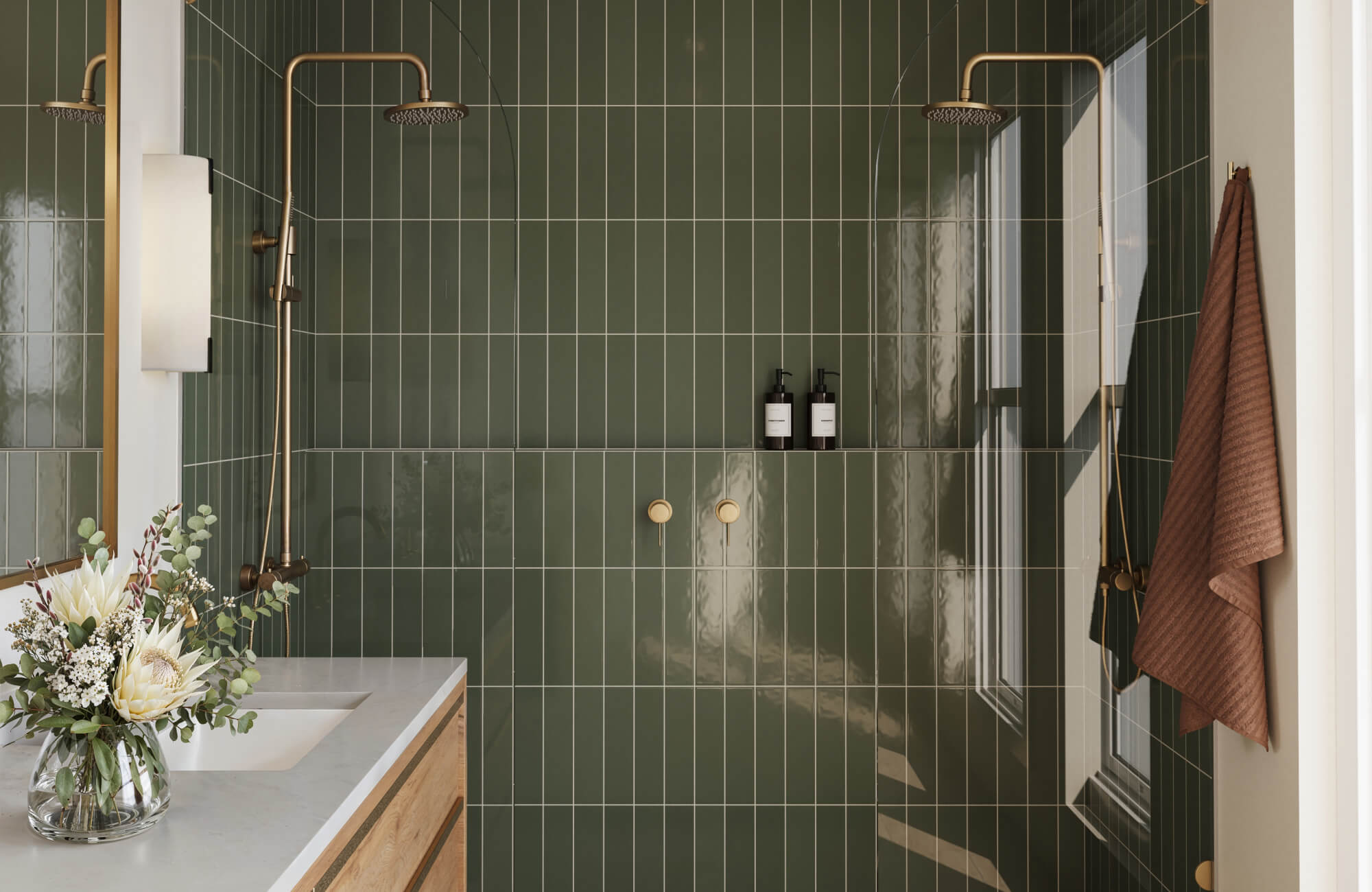Can a floor pattern define a space? Absolutely, especially when it's the timeless checkered tile. But beneath this geometry lies an important choice: porcelain or ceramic? While both tile types can deliver the classic charm or modern flair of a checkered layout, their differences in composition, performance, and practicality are anything but subtle.
From installation requirements to long-term durability, the right choice depends on how and where you plan to use them. Whether you’re renovating a busy foyer, styling a boutique café, or designing a serene bath retreat, understanding the nuances of each option is key. In this blog, we’ll break down the pros and cons of checkered porcelain vs. ceramic tiles to help you confidently match material to vision.
Decoding Durability and Longevity
When durability is just as important as design, the materials you choose need to stand the test of time, both structurally and aesthetically. To better understand how porcelain and ceramic tiles hold up under pressure, let’s look at what sets each one apart in terms of strength, wear resistance, and long-term performance.
A Deep Dive to Porcelain
Porcelain tiles are known for their exceptional durability, largely due to their dense, vitrified composition created by firing refined clay materials, such as kaolin clay, feldspar, and silica, at temperatures exceeding 2,300°F (1,260°C). This process results in a hard, low-porosity tile with a water absorption rate below 0.5% (per ANSI A137.1), making it highly resistant to moisture and frost.
With a high Mohs hardness rating (typically 7 or above) and strong breaking strength, porcelain is ideal for demanding environments like commercial spaces, kitchens, and entryways. Its through-body construction, where color and pattern run throughout the tile, helps mask chips and wear, while its low porosity minimizes staining and supports easier maintenance. These qualities make porcelain a long-lasting, low-maintenance solution for both indoor and outdoor applications.
Exploring The Limits of Ceramic
Ceramic tiles, while still dependable, differ in performance due to their lower firing temperatures (around 1,800°F or 980°C) and softer clay composition. This results in a more porous tile, with water absorption rates typically between 3% and 7%, which can limit its suitability in high-moisture or exterior settings unless specifically rated for such use.
With a Mohs hardness of 5 to 6, ceramic is more susceptible to chips and surface wear, especially under heavy impact. However, its lighter weight and easier workability make it a practical and cost-effective option for walls, backsplashes, and non-busy floors. With proper care, ceramic tile can still provide 20 to 30 years of service in residential settings, though it may require more frequent touch-ups or replacement compared to porcelain.

Aesthetic Versatility and Design Options
While function lays the foundation, it's often the aesthetic that brings a space to life, and few styles make a statement quite like checkered tile. From timeless motifs to unexpected twists, both porcelain and ceramic tiles offer unique creative opportunities worth exploring.
Classic Patterns and Modern Interpretations
Long associated with alternating black and white squares, the checkered tile pattern has been a design staple since the Renaissance and Victorian eras, where it conveyed symmetry and sophistication. Today, the motif has evolved with modern design trends, appearing in various color palettes, finishes, and scales to suit minimalist, industrial, or eclectic interiors.
Porcelain tiles, in particular, lend themselves well to these updated interpretations. Their precise calibration and rectified edges enable sharp layouts with tight grout joints, while a variety of finishes, matte, polished, or textured, enhance their stylistic range. Large-format and digitally printed porcelain options can even replicate materials like marble, cement, or wood, bringing traditional geometry into a contemporary context.
A refined example is Edward Martin’s Leona 12x12 Checkerboard Matte Porcelain Tile in Calacatta and Amani Grey, which blends marble-like veining with timeless patterning. As seen in the photo above, its soft matte finish makes it ideal for spaces such as bathrooms, foyers, or boutique-style interiors where elegance and performance are equally important.
Industry experts are also moving beyond traditional layouts by experimenting with diagonal, offset, or micro-check patterns. These approaches add visual rhythm and depth, allowing for dynamic expression in both residential and commercial environments. As always, success depends on careful planning, specifically, choosing the right scale, contrast, and layout precision.
Design Flexibility
Ceramic tiles are celebrated for their versatility, particularly their ability to be glazed, printed, and molded into a wide range of styles. Thanks to advances in inkjet and mold technologies, ceramics can convincingly mimic artisanal materials like hand-painted terracotta, Moroccan zellige, or vintage encaustic cement.
While porcelain excels in structure, ceramic shines in decorative applications. Its surface can showcase bold patterns, intricate textures, or gradient color shifts, making it a favorite for backsplashes, shower walls, or medallion accents. Available in a variety of glaze finishes, including glossy, satin, crackle, and metallic, ceramic tiles bring tactile depth and visual richness to interior surfaces.
Additionally, their lightweight nature and easy workability give you greater freedom with mosaic layouts, curved installations, or mixed-material combinations. From modern patchworks to traditional Mediterranean schemes, ceramic tiles lend themselves well to expressive, customized design, particularly in residential, retail, and hospitality spaces where aesthetics take center stage.

Cost Considerations: Initial Investment and Long-Term Value
Budget is often a key factor in any renovation, but understanding what you’re actually paying for can make all the difference. From manufacturing methods to long-term performance, porcelain and ceramic tiles each come with distinct cost considerations that go beyond the price tag.
Porcelain Tile Pricing Factors
Porcelain tiles typically come with a higher initial cost due to their refined raw materials, advanced manufacturing, and durability. Made from purified kaolin clay and fired at temperatures above 2,300°F, porcelain becomes dense, vitrified, and frost-resistant, traits that justify its premium pricing.
Material costs generally range from $4 to $10 per square foot, with additional expenses for features like through-body color or large format tile printing. Installation is also more labor-intensive, averaging $8 to $15 per square foot, as porcelain’s hardness requires specialized tools and experienced installers. However, these costs are often balanced by the tile’s impressive longevity, up to 50 years, and minimal maintenance requirements.
Edward Martin’s Palmer 12x12 Checkerboard Raw Porcelain Tile in White and Grey is a great example. As shown in the photo above, its matte, textured finish and frost resistance make it ideal for outdoor spaces, combining durability and style in one package. Porcelain’s resistance to moisture, abrasion, and staining reduces the need for sealing or refinishing, making it particularly cost-effective in busy areas over time.
Ceramic Tile Affordability
Ceramic tiles, by contrast, offer a more budget-friendly alternative. Standard glazed options typically range from $1 to $5 per square foot, with installation averaging $5 to $10, depending on project complexity. Their lighter weight and easier workability reduce both material and labor costs, making them ideal for cost-conscious projects.
Although not as hard or dense as porcelain, ceramic performs well in lower-impact settings such as backsplashes, bathroom walls, or lightly used floors. Its wide range of styles and finishes allows for budget-conscious remodels without sacrificing visual appeal.
That said, ceramics’ higher porosity and lower impact resistance may result in more frequent repairs or earlier replacement, particularly in moisture-prone or busy areas. Still, when properly installed and maintained, ceramic tiles can last 20 to 30 years, delivering solid long-term value for many residential applications.

Maintenance and Cleaning Ease
After installation, what often matters most is how well your tile holds up to daily life, and how much effort it takes to keep it looking its best. With that in mind, porcelain and ceramic tiles reveal key differences in maintenance needs, driven largely by their surface properties and porosity.
Low Maintenance Luxury
Porcelain tile is known for being exceptionally easy to maintain thanks to its dense, low-porosity structure, typically absorbing less than 0.5% of moisture, per ASTM C373 standards. Most varieties require no sealing, even in wet areas, because of their vitrified body and factory-applied finishes.
Routine care involves a damp mop and a pH-neutral detergent or mild soap. For tougher stains, porcelain’s resistance to alkaline and acidic cleaners ensures deeper cleaning without damage, an asset in commercial or hospitality settings. While polished porcelain may require microfiber tools to avoid streaks, it remains highly resistant to scratching, staining, and chemical exposure overall.
An excellent example is Edward Martin’s Brody 24x24 Checkerboard Matte Porcelain Tile in Sand and Dune, which pairs warm tones with a matte finish and large format to reduce grout lines and simplify upkeep. Its water- and UV-resistant qualities also make it suitable for sunlit or high-moisture areas, helping maintain long-term visual appeal with minimal effort.
Ceramic Tile Care Considerations
Ceramic tile, while still manageable, generally needs more attentive maintenance due to higher porosity and a softer glaze. Moisture absorption typically ranges from 3% to 7%, and although glazed surfaces offer some protection, the tile body underneath remains more vulnerable to staining and wear.
Daily cleaning should be gentle, using a soft broom or vacuum and a pH-neutral mop solution. Ceramic is more sensitive to abrasives and harsh chemicals, particularly if the glaze is thin or worn. Matte finishes can also show dirt more easily, requiring more frequent cleaning in busy areas.
While sealing the tile surface is usually unnecessary, protecting grout lines is advisable, especially in moisture-prone zones like bathrooms or backsplashes. Ensuring good ventilation and addressing spills quickly helps prevent mold, mildew, and water intrusion, preserving both the appearance and integrity of the installation.

Installation Complexity and Requirements
Getting the look and longevity you want from tile doesn’t just depend on the material, it also hinges on how well it’s installed. From the tools required to the level of expertise involved, porcelain and ceramic tiles each bring their own set of challenges and advantages to the installation process.
Porcelain Tile Installation
Porcelain tile is known for its technical challenges, primarily due to its density, hardness, and rectified edges. These characteristics, while beneficial for durability, make the material more difficult to cut and install. Standard tile cutters often fall short, requiring a wet saw with a diamond blade to produce clean edges.
Rectified tiles, which are precisely finished for minimal grout joints (as small as 1/16"), demand extremely flat substrates and careful alignment to prevent lippage, especially with large-format tiles. This increases the importance of proper subfloor preparation using leveling compounds and suitable underlayments.
Additionally, porcelain’s weight calls for stronger adhesives like modified thin-set mortars (meeting ANSI A118.4 or A118.15), and in some cases, back-buttering to ensure full coverage. For vertical installations, mechanical anchors may be necessary, particularly with heavier or oversized tiles. Given these complexities, professional installation is often the best path to ensure durability, safety, and a polished finish.
To further streamline your tile selection, Edward Martin’s Augmented Reality (AR) Visualization Tool lets you preview porcelain tiles directly in your space. Simply tap “View in Your Space,” point your device, and see your chosen tile in real time, making it easier to assess layout, scale, and fit. And when you're ready, you can order tile samples to confirm your choice with confidence.
Ceramic Tile Installation
Ceramic tile, by contrast, is much more manageable, making it ideal for residential or DIY installations. Its softer composition allows for easy cutting with manual tools, reducing the need for specialized equipment and helping lower labor costs.
The material’s lighter weight and standard edge tolerances also make it more forgiving of slight subfloor imperfections. Wider grout joints (typically around 1/8") help mask minor alignment issues, making ceramic well-suited for quicker, less complex installations.
Standard unmodified thin-set mortars (per ANSI A118.1) are usually sufficient for most applications. While waterproofing is still recommended in wet areas, ceramic’s reduced weight and ease of handling simplify vertical applications like backsplashes, tub surrounds, and accent walls, particularly when time or budget is limited.

Environmental Impact and Sustainability
As eco-conscious design takes center stage, it's worth looking beyond surface appeal to consider how your tile choices affect the planet. From energy use during manufacturing to material longevity and recyclability, porcelain and ceramic tiles offer distinct environmental trade-offs worth unpacking.
Porcelain Tile Sustainability
Porcelain tiles are exceptionally durable, with lifespans often exceeding 50 years and minimal maintenance needs. This longevity reduces the frequency of replacements and associated waste, which positively impacts long-term sustainability metrics like Life Cycle Assessment (LCA) scores.
However, this performance comes at a cost. Producing porcelain requires high firing temperatures (over 2,300°F) and energy-intensive processes. The mining of kaolin clay, feldspar, and silica also contributes to carbon emissions and environmental disruption. While manufacturers are improving kiln efficiency and exploring renewable energy, porcelain’s embodied energy remains relatively high.
That said, responsible sourcing can mitigate some of these concerns. Edward Martin’s Leona 12x12 Checkerboard Polished Porcelain Tile in Calacatta and Amani Bronze offers a sophisticated, VOC-free option that balances style with eco-conscious design. As displayed above, its light-reflective finish and marble-inspired look show that sustainability doesn’t have to compromise elegance.
Porcelain's sustainability improves further when produced by manufacturers adhering to certifications like Green Squared®, LEED, or ISO 14001. Some also incorporate recycled content, such as fired scrap or post-consumer materials, to reduce dependence on virgin resources.
Ceramic Tile Environmental Considerations
Ceramic tile generally carries a smaller environmental footprint at the production stage. Fired at lower temperatures (around 1,800°F) and made with widely available natural clays, ceramic requires less energy and emits fewer greenhouse gases compared to porcelain. This makes it a more efficient choice for projects aiming to minimize upfront carbon impact.
Many ceramic manufacturers are also embracing eco-friendly practices, such as closed-loop water systems, waste heat recovery, and recycled content integration, often ranging from 10% to 40%. These strategies support environmental certifications, including LEED and WELL Building Standard® credits.
Beyond production, ceramic tiles are VOC-free, chemically stable, and compatible with water-based adhesives, supporting better indoor air quality. Although large-scale recycling infrastructure is still limited, ceramic tiles can be crushed and reused as aggregate in construction materials, extending their environmental value beyond their initial installation.
In short, while ceramic may not match porcelain in durability, its lower production impact and ongoing improvements in sustainable manufacturing make it a strong contender for environmentally conscious design.
Finding the Right Fit for Function and Flair
Hence, the right tile doesn’t just finish a room, it defines how it feels, functions, and endures over time. Whether you lean toward the lasting strength of porcelain or the expressive ease of ceramic, the checkered pattern becomes more than a design choice, it’s a reflection of your space’s story. At Edward Martin, we believe that every surface deserves a solution as intentional as the people who live with it. Let your next project start not just with vision, but with confidence.








